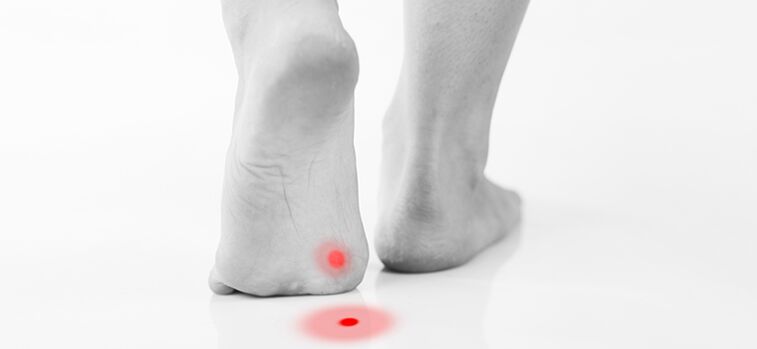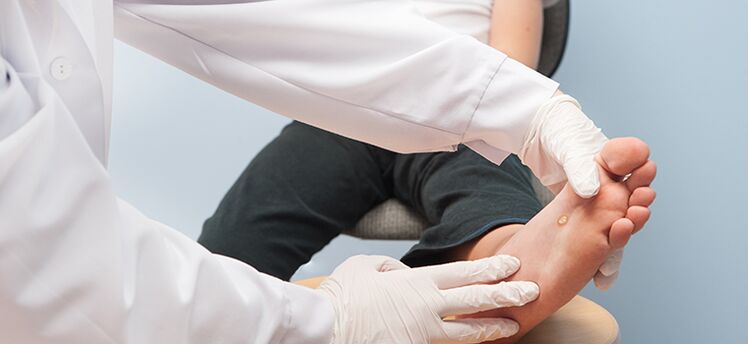plantar wart, or spike, appears as a firm to the touch, flat formation on the skin of the foot, which rises slightly above the level of the skin. This type of wart refers to tumors of the epithelium that are benign in nature and the diagnosis, as a rule, does not cause difficulties - the main method is dermatoscopy. The doctor, using a special device, visually determines the nature of the new formation. Warts can appear anywhere on the foot, but they usually form on the balls of the toes, heels, ie the places with the greatest pressure. The photo clearly shows what a plantar wart looks like, its appearance is quite specific and usually leaves no doubt about the diagnosis. The education has a dirty brown or unpleasant yellow color, characteristic rough papules are visible, which destroy the papillary patterns.

Because the tumor is located on the foot, it can cause pain and injury to the wart itself. For these reasons, the thorn needs to be treated, although there is little chance that a plantar wart will go away on its own without serious treatment.
Unfortunately, it is still not easy to get rid of warts, so it is recommended to consult a dermatologist to reduce the risk of infecting other people, as well as reduce the time to treat the disease. The use of extremely folk remedies and independent attempts to get rid of the tumor are undesirable. The plantar wart has a deep root that is almost impossible to remove on its own, so recurrences occur. Folk remedies often damage the surrounding tissues, which can lead to an increase in the area of damage and unpleasant consequences in the form of burns and scars.
Symptoms
If you suspect a neoplasm, you should not only know what the plantar wart looks like in the photo, but also remember that the disease has characteristic symptoms:
- palpable itching at the site of formation;
- the size of the warts is from a few millimeters to 2 centimeters;
- unlike corns, the wart brings pain;
- bleeding from injury;
- pain when walking.
If you have such symptoms, contact your doctor immediately. It is easier to prevent disease than to deal with the consequences.
Causes of plantar wart
Plantar wart is caused by an infection with the human papillomavirus (HPV) on the foot. The main route of transmission is contact, infection occurs through common objects or directly from person to person. Favorable environment is heat and humidity, so it is important to take precautions when visiting the bathroom, pool, sauna and gym.
A weakened immune system can also be the cause, as the human papillomavirus normally does not show visible symptoms.
This type of wart can also occur with microtrauma of the epidermis, dry skin, wearing uncomfortable shoes, hyperhidrosis. Also, the causes of warts on the feet can be diseases that lead to deformity of the foot - arthritis of the joints, osteoarthritis, flat feet, as well as diseases that lead to disruption of the integrity of the skin of the foot: diabetes, varicose veins. It should be remembered that frequent stress can indirectly affect the occurrence of this disease.
HPV can occur by accident when walking barefoot on an infected surface, the virus can live up to several months without a direct carrier. Once in the body, it may not appear for days or even weeks, so it is not always possible to know the exact time of infection.
Diagnosis
To determine how to treat plantar warts, the dermatologist conducted a series of tests:
- overview;
- dermatoscopy;
- PCR diagnostics;
- histological examination.
How to cure plantar warts

When a plantar wart appears, the question arises how to cure this neoplasm. When the growths cause excessive discomfort and spread quickly, the best solution is to contact a dermatologist as soon as possible, he will choose the most appropriate treatment option. There are several ways to solve this problem.
The most radical of these is surgery: the wart and its roots are removed surgically. This method is not the most effective, as the roots of the neoplasm are located in the deep layers of the skin. In some cases, it is not possible to remove them completely.
Removal of warts can be done with the help of laser and electrocoagulation, as well as through cryotherapy.
In addition to removal in medical facilities, plantar warts can be removed with less radical methods, such as ointments, solutions, special patches, and folk remedies. These plantar wart removers have a number of advantages and disadvantages, the main of which is the long treatment time.
Removal of plantar warts
One of the most common ways to remove plantar warts is to remove them in specialized medical facilities. The dermatologist during the meeting should tell you in detail how to get rid of plantar warts and based on the results of the examination to choose the most appropriate method. Despite the fact that thorns are difficult to treat, there are no special specific means to remove them, all methods are used that are suitable for the treatment of other types of warts. Plantar wart removal can be done on an outpatient basis, but your doctor may prescribe medication to help you remove the growths at home.
Surgical removal of warts
Among other treatments, surgery is used to remove warts. The wart is scraped with a special scalpel under local anesthesia. After this procedure, if the plantar wart was of significant size, sutures are placed under the skin, which are removed within one to two weeks. The wound site is treated with a disinfectant solution and an aseptic dressing is applied. There is usually a small scar at the site of removal.
The difficulty with this method is that the doctor must remove all the roots during the operation, otherwise the plantar wart will reappear. Therefore, this method is used today only if all other treatments have been ineffective.
Removal with liquid nitrogen
Liquid nitrogen removal involves exposing the neoplasm to extremely low temperatures, which is the most common modern and fastest way to treat plantar warts.
The method is based on freezing the forming tissue itself. In fact, inside the cells of the wart, under the influence of an extremely low temperature of -196 degrees Celsius, ruptures occur, leading to the death of the wart.
Cryodestruction is performed manually or hardware. If the wart is large or the procedure is performed on a child, then it becomes necessary to use local anesthesia.
The time of exposure directly to liquid nitrogen is up to 30 seconds. After the first cauterization, the doctor should pause to assess the effectiveness of the effect and the need for re-cauterization.
After freezing, a blister with a colorless or reddish liquid forms at the site of the wart, which indicates the beginning of the inflammatory process. This is a normal reaction to the cauterization procedure.
Cryosurgery is considered painless, but in the treatment of plantar warts should be repeated several times to achieve the final effect. Once the wart falls off, no scars remain.
The advantages of liquid nitrogen removal are:
- freezing eliminates the further spread of the disease to the nearest skin;
- lack of special training;
- short duration of the procedure;
- the risks of developing scars or scars are minimal.
The disadvantages of cryodestruction of plantar warts are:
- the need for a second course with a large area of damage or due to the size of the wart;
- the human factor - the professionalism of the doctor performing this procedure is a guarantee of success. The doctor must correctly assess the time and degree of nitrogen exposure in the tissues, otherwise burns may occur;
- the discomfort of a swollen bladder and the need to treat it are also considered disadvantages of the method.
In general, the feedback on the treatment of plantar warts by cauterization with liquid nitrogen is positive, as it is the simplest, most effective and affordable method.
Laser removal
Laser removal is considered one of the most effective and safe methods. After laser treatment, the wart ceases to be infectious. The procedure itself is painless, the laser has a special nozzle that cools the impact site. In addition, one or more anesthetic injections are given before the operation. The patient usually feels a slight tingling sensation during the procedure. After removal of the neoplasm, no traces remain, as the laser burns the diseased tissue directly. The laser method allows maximum control of the depth of exposure, which is individual for each case. Therefore, even with deep tissue lesions, it is possible to completely remove the roots, which means preventing the wart from regrowth.
The operation is performed under sterile conditions, there is no direct contact with the skin or the wart, and the duration of the operation is only a few minutes. The positive results of laser plantar wart removal also make this method the most attractive.
The main disadvantage of laser removal of plantar warts is the high cost, which usually includes consultation with a doctor, anesthesia and the operation itself. In addition, the wound after removal heals for a long time and requires compliance with hygiene rules.
Treatment of plantar warts
Before treating a plantar wart, you need to make sure that the diagnosis is correct and then proceed directly to the procedures. In addition to surgery, your doctor may prescribe immunotherapy and topical medications.
The need for immunotherapy, as a rule, is justified, as the disease is caused by a virus that is actively developing in a weakened state of the body. Topical immunotherapies directly affect the virus in two ways. In the first case, the drug stimulates the immune system, and in the second, an antigen is injected into the body of the wart, which also activates the immune system so that the wart disappears faster.
The treatment of plantar warts takes quite a long time, it is important not to forget to strengthen the immune system and maintain hygiene. If removal and treatment are not used, the wart can disappear on its own for more than a year, while the person is a source of infection for everyone around. You should carefully consider this unpleasant disease and be sure to contact a dermatologist, who will definitely tell you how and how to treat plantar warts.
The treatment of plantar warts directly depends on compliance with all hygiene standards and doctor's prescriptions, daily treatment of the formation is a guarantee of successful recovery.
Treatment at home
Any new skin growths should not be ignored, as the tension of cancer is growing worldwide. Do not neglect the meeting with a specialist, he may prescribe treatment for plantar warts at home. In this case, special solutions, ointments and a wart patch are usually prescribed.
Ointments are one of the mildest methods of treatment, acting on the wart itself, as a result of which it gradually dies and disappears. The following types of ointments are used in the treatment:
- antiviral ointment;
- acid-based ointment;
- various ointments based on herbal medicines.
Each type of ointment is applied topically to the wart several times a day according to the instructions. In the treatment of plantar warts, before applying the drug, it must be pre-steamed in warm water. It is recommended to apply each ointment at night so that you do not have to step on the formation and wash off the ointment.
To get rid of plantar warts at home, you can use a special patch based on salicylic acid. This tool has a low cost and proven effectiveness. The patch is sold in pharmacies without a prescription, the principle of its use is very simple - the wart is sealed with a piece of patch, and a simple medical patch is fixed on top. You should change the patch at regular intervals. Removing a small wart can take about two weeks and you should not leave the wart without a patch for a long time. As the treatment progresses, the area of the wart decreases, after 12 hours it is covered with a crust, which then disappears. After successful treatment, a small pink spot remains on the skin, which should disappear completely over time.
Care should be taken when applying the patch - healthy areas of the skin should be avoided when applying it, otherwise severe irritation may occur. There are contraindications to the use of this method to remove the wart, so the decision to prescribe the patch should be made by your doctor.
Another way to treat plantar warts at home is hyperthermia. Legs affected by warts are immersed in the hottest possible water. Such procedures are repeated several times. In some cases, hyperthermia shows a positive effect. The mechanism of the procedure is based on the excitation of small blood vessels in the legs and the activation of local immunity.
At home you can use the treatment of low temperatures by analogy with the removal of warts with liquid nitrogen. To do this, you can use special applicators or sprays. As with cryosurgery, multiple applications may be required.
Treatment with folk remedies
Despite the fact that modern medicines are much more effective and with their help the process of removing plantar warts is faster, the effectiveness of folk remedies can not be denied. Traditional medicine has gained vast experience in combating warts and some methods remain effective.
- Celery juice is one of the most popular ways to remove thorns. You can use the juice of a fresh plant or buy a drug at the pharmacy, which contains in addition to the juice of celandine and other herbal extracts. The juice is applied once or twice a day on the affected area.
- Acetic acid, along with various additional products, is also used to remove warts. In addition to acid, onions and flour are used. You can drip the acid directly on the affected area, but this method is quite dangerous due to the high risk of severe burns.
- Apple cider vinegar: a swab soaked in the solution (it is important not to use undiluted vinegar) is applied to the affected area of skin, the skin is pre-treated with an abrasive nail file.
- Garlic is another folk remedy for treating warts. Raw garlic should be rubbed on the formation until it disappears completely, but this method can be used for no more than three weeks.
- Banana peel is applied with the inside on the affected area of skin, it is believed that it can stretch the wart.
To draw the location of the lesion and not to touch the adjacent tissues, you can use a piece of adhesive tape. A hole is made in it according to the size of the neoplasm, and the adjacent healthy skin remains intact. This avoids burns and other injuries.
Plantar wart in a child
With age, a person develops immunity to HPV, so children and young people are more susceptible to this infection. The disease most often affects children over the age of five. Your doctor will help you identify a plantar wart in a child, as in some cases it may look like old corn.
Although plantar warts in a child go away on their own, their treatment should not be neglected, it is also worth remembering the possibility of infecting the whole family and the people around them. Plantar wart in a child almost always causes severe painful discomfort when walking, which requires immediate treatment and a visit to the doctor.
Because children are sensitive to pain, it is quite difficult to find therapy. For starters, it is worth using different ointments - they are affordable, easy to use and effective. Folk remedies are also widely used, the safety of which cannot be doubted.
Effective methods for removing plantar warts in children are liquid nitrogen and laser removal. Removing warts with these methods is one of the most radical methods. They are resorted to in cases where solutions and ointments do not have the desired effect.
After treatment, it is important not to forget about the prevention of plantar warts in children. This is strengthening the immune system, careful hygiene and wearing appropriate comfortable shoes. It should be remembered that the risk of infection is particularly high in public and from another person, so you need to make sure that the child does not walk in someone else's shoes or barefoot. Anything that has come into direct contact with the formation should be washed thoroughly at high temperature. All these actions will help prevent the development of the virus in the future.
Danger
If the plantar wart removal procedure is not performed in time, it can lead to serious consequences, such as:
- the appearance of warts on other areas of the skin;
- skin cancer.
Doctors strongly advise against self-medication - cutting, piercing or cauterizing warts will worsen the situation and lead to the formation of new warts.
Risk group
The risk group is:
- people with hormonal disorders in the body;
- HIV-infected.
Prevention

For the prevention of plantar warts patients are recommended:
- strengthening immunity;
- eat more foods rich in vitamins;
- proper care of the skin of the feet;
- do not wear tight shoes, shoes made of synthetic materials;
- do not walk barefoot in public places (locker rooms, showers).















